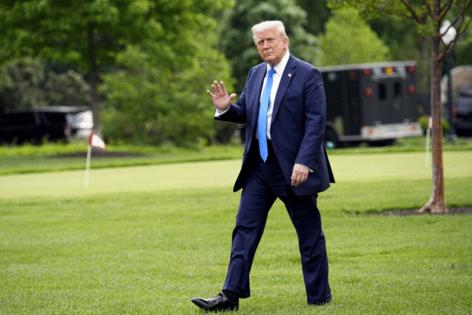White House unveils reconciliation-augmented fiscal 2026 budget
Published in News & Features
WASHINGTON — President Donald Trump is proposing steep cuts to domestic and foreign aid spending for the fiscal year that begins Oct. 1 coupled with hefty increases for defense and border security, with the help of GOP lawmakers already writing separate legislation outside of the annual appropriations process.
The “skinny” version of the White House’s budget blueprint released Friday envisions a more than 13% increase to defense and related spending, topping $1 trillion in that category for the first time. That $119 billion increase, which includes $6 billion for the Energy Department’s nuclear programs, would come entirely through the “big, beautiful” budget reconciliation package Republicans have begun drafting.
As a result, appropriators could simply keep discretionary funding for the Pentagon and other national security accounts flat from what was provided in the fiscal 2025 full-year stopgap package.
Defense hawks on Capitol Hill raised concerns almost immediately. Senate Armed Services Chairman Roger Wicker, R-Miss., said the flat discretionary defense budget would be a cut when factoring in inflation.
“The Big, Beautiful Reconciliation Bill was always meant to change fundamentally the direction of the Pentagon on programs like Golden Dome, border support, and unmanned capabilities — not to paper over (the Office of Management and Budget)’s intent to shred to the bone our military capabilities and our support to service members,” Wicker said.
Senate Appropriations Chair Susan Collins, R-Maine, and Defense Appropriations Subcommittee Chairman Mitch McConnell, R-Ky., shared similar criticism.
A White House official defended the strategy, calling it a “more durable” way to reach $1 trillion in defense spending and cited support from Senate Budget Chairman Lindsey Graham, R-S.C.
Collins said she had “serious objections” to both the flat discretionary defense spending and proposed cuts to biomedical research, low-income heating subsidies and Education Department services for individuals from disadvantaged backgrounds.
The $119 billion boost to defense is entirely offset by equal cuts to nondefense programs in fiscal 2026, amounting to a nearly 17% reduction on average, keeping overall agency budgets flat at a little over $1.6 trillion next year, according to Office of Management and Budget documents.
And that’s after an assumed $42 billion increase for the Department of Homeland Security, stemming from the agency’s own reconciliation boost. Excluding border and immigration enforcement funding from the calculation, the rest of the nondefense budget would be cut by roughly $162 billion, or nearly 25% next year if Congress follows the Trump blueprint.
Nearly every nondefense agency would face deep cuts under the proposal, which would provide $601.2 billion in nondefense funding, including the reconciliation money going to DHS. Most prominent are a nearly 48% cut to the State Department, a 44% cut to the Department of Housing and Urban Development and an over 26% cut to the Department of Health and Human Services.
Senate Appropriations ranking member Patty Murray, D-Wash., said Trump’s budget would “eviscerate programs that matter most to working families.” Murray also took aim at proposed cuts to scientific and biomedical research, which she said would make Chinese President Xi Jinping happy.
The Pentagon and DHS are the biggest beneficiaries in a budget with very few winners overall, with 13% and 65% increases, respectively, after including reconciliation funds.
The administration believes the simple-majority Senate vote that the reconciliation process allows will let Trump get defense and border funding boosts without “being held hostage by Democrats for wasteful nondefense spending increases as was the case in President Trump’s first term,” the administration said in a statement.
“The resources provided would allow DHS to implement the President’s mass removal campaign and secure the border,” the statement says.
The Transportation and Veterans Affairs departments are poised for increases under the proposal. Transportation’s budget would grow by $1.5 billion, or just under 6%, while the VA’s would grow by $27.6 billion, or over 17%, after accounting for mandatory funds provided under the 2022 toxic exposure benefits law. The VA’s discretionary spending level would increase by $5.4 billion, or just over 4%, under the request.
Excluding DHS and the VA, overall nondefense agency budgets are facing a 32% cut, as Trump, OMB Director Russ Vought and the Elon Musk-led “Department of Government Efficiency” seek to dramatically shrink the size of government.
The State Department’s actual funding level would dip to $31.2 billion, from the $59.6 billion current level. A large portion of that funding would be offset by cancellations of prior spending, however, and the administration is proposing just $9.6 billion in new appropriations for State.
“The budget ensures that foreign aid spending is efficient and consistent with U.S. foreign policy under the America First agenda,” the fact sheet says.
Cuts to other Cabinet departments range from 8% for the Justice Department to 35% for Labor, according to a funding table provided by the White House budget office.
The proposal would also decimate some smaller agencies like the EPA, which is facing a nearly 55% cut, from $9.1 billion to $4.2 billion. The National Science Foundation is looking at a similar fate, with a nearly 56% cut, from $8.8 billion to $3.9 billion under the proposal.
Also in the line of fire is NASA, which the administration wants to cut by 24%, or $6 billion. The budget proposes $7 billion for lunar exploration and $1 billion for “Mars-focused programs,” but workforce layoffs, reductions to science accounts and other cuts would bring total funding down.
The White House also released related fact sheets on the following:
—Cuts to programs the administration labels as promoting “racial and gender ideologies” and “cultural Marxism” the president wants to eliminate.
—Border enforcement and deportation efforts.
—“Ending weaponization of the federal government.”
—Climate programs and energy production.
______
(Paul M. Krawzak contributed to this report.)
©2025 CQ-Roll Call, Inc., All Rights Reserved. Visit cqrollcall.com. Distributed by Tribune Content Agency, LLC.







Comments